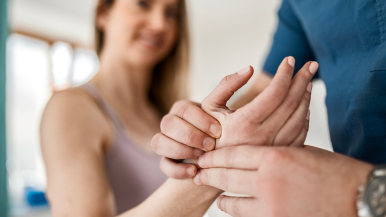6 Easy Stretches to Reduce Back Pain
 Try doing these 6 easy stretches to reduce back pain right at home.
Try doing these 6 easy stretches to reduce back pain right at home.
Back pain can be, well, a pain. Lower back pain, in particular affects almost everyone at some point during their lives. While it may be tempting to lie in bed all day, that can actually make the problem worse. Luckily, there are several basic stretches to help you get out of bed, off the couch, and back on the go.
Keeping the following helpful tips in mind can make sure you get the most out of your stretches:
- Try to remain in whatever pose you choose for at least 10 seconds; although a minimum of 30 seconds is ideal to allow joints and muscles to adequately stretch
- Stretching should not be painful. You may feel slight discomfort, but it should feel like a gentle pulling sensation
- Don’t force your body into a pose that’s too difficult
- Stretches should be done on a firm, flat surface
- Wear comfortable shoes that will stop you from sliding on the floor
- Move into the stretch slowly and hold without bouncing
Before starting any kind of stretching or training regimen, you should consider consulting a licensed physical therapist to help you understand your back pain and determine which exercises would be most beneficial for you. A physical therapist can create an individualized program specifically geared toward your goals. Your program may include stretching, strengthening, stabilization, manual therapies, modalities, and education. Your physical therapist can provide important information on the source of symptoms and educate you on the nature of your back pain to maximize your results.
Stretch 1. Knee to Chest
Lie on the ground with toes pointed to the ceiling, bend the right knee slowly and pull your leg toward your chest gently. Stay in this position for at least 20 seconds, then slowly release and straighten the leg to return to the starting position. Repeat 3 times for both legs.
Knee to chest is an effective way to address lower back pain not only because it stretches the lower back and gluteal muscles, but also because it can help to increase overall flexibility and improve range of motion in the joints. Be cautious with this stretch if you have been diagnosed with osteoporosis.
Stretch 2. Child’s Pose
Child’s pose, also known as prayer stretch, helps the lower back muscles along the spine. Start on the floor on your hands and knees with hands positioned under the shoulders and the knees under the hips. Then, reach out directly in front of you, extend the arms, and place palms face down. Slowly sit your hips back toward the heels while dropping your head and chest to extend arms further. Hold this position for 20 to 30 seconds.
Child’s Pose isn’t just for yogis. If the stretch feels too intense, try placing a pillow under your stomach to prop you up to lessen the stretch of the lower back muscles. You can also place a pillow or rolled up towel under the knees to provide additional cushion. Several other yoga poses can help stretch lower back muscles, such as cat/cow stretch, seated forward fold, downward and upward facing dog.
Stretch 3. Flexion Stretch
The name sounds complicated, but actually the flexion stretch is very simple. Gently bend the head forward while simultaneously moving the chin toward the chest. You can do this stretch while standing or sitting. Hold the stretch for 20 to 30 seconds
This stretch helps relieve stiffness in the neck – which often accompany a stiff back.
Stretch 4. Lying Knee Twist
Begin lying down on your back with the legs extended straight out. Then, bend the right knee up and cross it over to the left side of the body. Hold for 20 to 30 seconds to feel the stretch through both the lower back and buttocks and repeat three times on each side.
The stretch helps improve flexibility but can also strengthen muscles along the spine and in the abdomen.
Stretch 5. Cobra Pose
Cobra pose is another yoga-based stretch that can help to alleviate certain types of back pain. Starting from the plank position, which many serious yogis do, would be a mistake for the purposes of this stretch. You should start by lying on your stomach and allowing the floor to be your support. Then, arch your back while descending your shoulder blades down your back to support the upper spine while it arches.
Although cobra pose is an effective back stretch, it is not appropriate for all types of back pain. If you have been diagnosed with a spondylolisthesis or facet joint pathology, take caution when performing this stretch.
Stretch 6. Prone Press Up
Prone press up is a good lumbar extension stretch, which can be especially beneficial for people who may have a disc lesion. Start by lying on your belly with your elbows bent underneath you and with palms flat on the surface (similar to push up position). Lift your upper torso off the surface with your arms while keeping your back muscles relaxed and hips and pelvis on the ground. Exhale as you press up to relieve pressure in the abdomen and improve the stretch. Go as high as you feel comfortable, and do 10 repetitions of this holding for 10 seconds each.
Why Stretching Helps Your Back
Exercise, fitness and stretching help to keep the back healthy because the discs are able to exchange fluids. Fluid exchange facilitates nutritional intake for the discs, and discs suffering from a lack of fluids can become degenerated and malnourished. Fluid exchange also helps to reduce any potential swelling in nearby tissues.
Additionally, exercising the back helps decrease stiffness by keeping the connective tissue fibers of ligaments and tendons flexible. Improved mobility helps to prevent the connective tissue fibers from being injured when under stress. This ultimately helps to prevent future injury and back pain. Stretching and stabilization helps to build up the muscles around the back, which contributes to alleviating pain.
Remember: you should never engage in exercise or stretching that causes shooting pains or extreme discomfort. If this occurs you need to make sure you’re positioning yourself correctly and then consult a licensed physical therapist for further evaluation.



